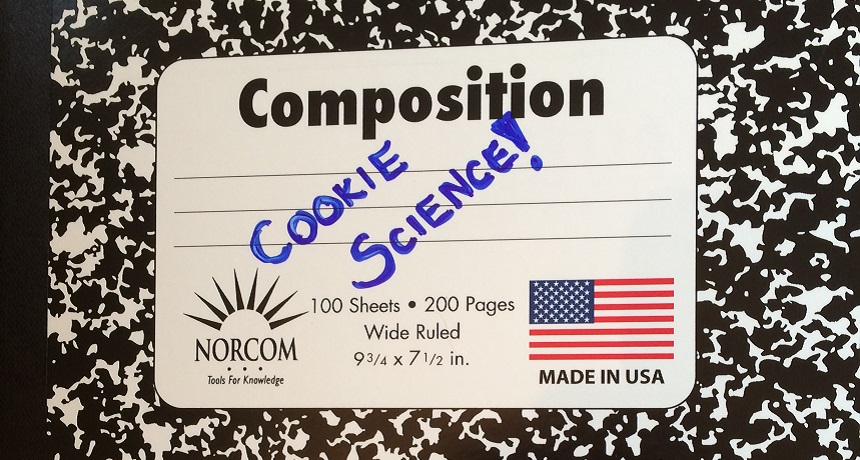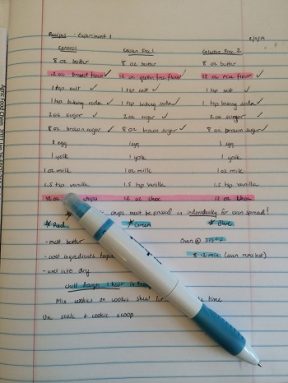Cookie Science 3: The lab notebook
One of the most important aspects of scientific research is keeping careful records

I’m making sure to keep track of my cookie science experiments with a lab notebook.
B. Brookshire/SSP
This article is one of a series of Experiments meant to teach students about how science is done, from generating a hypothesis to designing an experiment to analyzing the results with statistics. You can repeat the steps here and compare your results — or use this as inspiration to design your own experiment.
People have many different ideas of what “doing science” looks like. Some picture bubbling beakers. Others may think of training binoculars on animals in exotic environments. What few people imagine are scientists surrounded by piles of paper. But in fact, one of the most important things about doing an experiment is writing down everything you do. In detail. Sometimes you may even tape down box tops, photos or other things to document what materials you used, what your test apparatus looked like or how much some chemical reaction transformed the materials you worked with.
Welcome back to Cookie Science! In this series, I’m designing and carrying out a scientific experiment to create a gluten-free cookie for my friend. She can’t have gluten, a protein found in the wheat flours used to make most cookies. So I need to change my recipe, creating a cookie she can safely eat. I have a goal and a hypothesis.
Now I need to design my experiment. This means I need to write it down. One of the most important concepts in science is replication. That’s the idea that someone can repeat another’s experiment and get the same result. For you to replicate my recipe testing, I will need to tell you exactly what ingredients I used, how hot my oven was (which may not be the same as the temperature I had turned the dial to) and even the order in which I baked different batches of my cookies.

So I keep a lab notebook. In it, I write down everything I plan to do. Because I use a computer to write up a lot of my plans, I print out copies and staple them into the notebook. I draw diagrams of how I’m laying out the dough on the cookie sheet. As I bake up those cookies, I include the ingredients used for each recipe, checking them off as I go. Along the way, I note details of any mistakes I make, any observations that appear odd and perhaps even how things look or smell.
My notebook helps me to stay on track. The details allow me to relive every step of each experiment. And all of those minutiae I record will later help me interpret my results. My lab notes will even help me write about my experiment in enough detail that other people can repeat my tests. Hopefully, if my instructions are clear and detailed enough, other bakers will be able to replicate my results.
I also initial and date each page of my lab notebook as I complete it. This shows someone else reading it that what I have put in the notebook is complete and that I stand behind it.
A lab notebook is even more important that your test tubes, ovens or ingredients. It’s the first step to keeping good track of your work. It’s the record of the science you’ve performed. And it’s the first step toward making sure other people will be able to replicate your findings.
Follow Eureka! Lab on Twitter
Power Words
Gluten A pair of proteins — gliadin and glutenin — joined together and found in wheat, rye, spelt and barley. The bound proteins give bread, cake and cookie doughs their elasticity and chewiness. Some people may not be able to comfortably tolerate gluten, however, because of a gluten allergy or celiac disease.
hypothesis A proposed explanation for a phenomenon. In science, a hypothesis is an idea that hasn’t yet been rigorously tested. Once a hypothesis has been extensively tested and is generally accepted to be the accurate explanation for an observation, it becomes a scientific theory.
replication (in experimentation) Trying to get the same result as an earlier test or experiment — often one performed by someone else. It depends upon repeating every step of a test, step by step. If a repeated experiment generates the same result as in earlier trials, scientists view this as verifying that the initial result is reliable. If results differ, and all the steps of the test were the same, the initial findings may fall into doubt. Generally, a scientific finding needs to be replicated to be accepted as true.